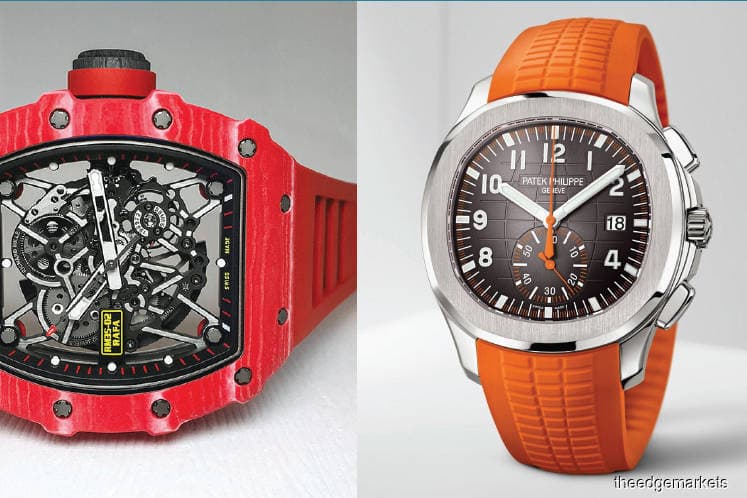
This article first appeared in Personal Wealth, The Edge Malaysia Weekly on February 18, 2019 - February 24, 2019
The outlook for watch investments in the country appears to be mixed as Malaysians exercise caution in the face of a volatile economy. Mid-range timepieces will be the most affected by the slowing economy, but high-end ones will continue to be in demand.
Datuk Seri Darren Chong, owner of Watch & Co, believes that collectors will still invest in high-end watches on the secondary market. He says a slow economy will not affect the high-end market because most investors know that if they are not able to sell their watches on the local market, they can sell it overseas because there will always be demand. So far, the brands that have seen the highest demand are Richard Mille, Patek Philippe, Rolex and Audemars Piguet.
“I have some customers who would rather buy and keep watches instead of holding currencies because they know that they will be able to sell them at a higher value — whether in ringgit, euro, pound sterling or US dollar — a few years down the road,” says Chong.
“I am always confident when it comes to watches because, above anything else, they are liquid investments which we can buy and sell anytime. There will always be a willing buyer and seller.”
As for mid-range watches, the market has been tough since the middle of last year, says Andy Yee, managing director of Hing’s Watch Sdn Bhd. He believes that the situation will remain the same this year.
“Luxury brands are coming out with fewer collections and limited edition pieces. So, we can tell that the market will be slow,” says Yee.
The most sought-after brands include high-end watches such as Rolex, IWC and Jaeger LeCoultre and mid-range ones such as Breitling and Tag Heuer, he adds.
According to Deloitte’s
Fashion & Luxury Private Equity and Investors Survey 2018 global report, even though interest is declining compared with 2017, watches, jewellery and digital luxury remain attractive to investors. Also, despite a slowdown in the Asian market, investors’ attraction to watches and jewellery remains stable due to their appeal as less volatile assets.
When it comes to high-end timepieces, Rolex remains a highly sought-after brand, especially the Submariner and Daytona, say experts.
Chong says there is demand for Richard Mille watches as the timepieces can double in value in just three years. Some Patek Phillipe watches can fetch similar returns, but this depends on the condition of the piece.
Chong names Richard Mille’s RM 11-03 Automatic Flyback Chronograph and RM 35-02 Automatic Rafael Nadal as the ones to keep an eye on as they could see a return of about 23% in five years. For Patek Philippe timepieces, his picks are the Nautilus and Aquanaut collections, which he says can see returns of up to 200% in 10 years. As for Audemars Piguet watches, the Royal Oak and Royal Oak Offshore collections could see a return of 15% in 5 to 10 years.
According to luxury investment website Collector Square’s LuxPrice-Index, a Patek Philippe Aquanaut 5065 sold for €34,227 (RM157,473) on the secondary market last April while a Nautilus went for €499,738 the following month. Meanwhile, an Audemars Piquet Royal Oak sold for €122,385 in May last year.
When it comes to mid-range timepieces, Tag Heuer’s Carrera collection is the one to look out for. According to luxury watch website TimeRating.com, the Tag Heuer Carrera Calibre 1887 Automatic Chronograph has seen an average annual price increase of 4.4% over 14 years (as at 2016).
Yee says Breitling watches, specifically the Navitimer collection, should see good returns as well. TimeRating.com says the Breitling Navitimer 01 has generated an average annualised return of 2.1% over three years and seen an average price growth of 6.2% over 10 years (as at 2016).
Chong is also the owner of Watchclub, a luxury watch shop that has been around for seven years at Publika in Kuala Lumpur. He regularly posts pre-owned timepieces on its Facebook page, Watchclub Publika, because most investors seek out watches on the secondary market before considering new pieces.
“Most collectors understand that used pieces have more value than brand-new ones. If you buy a new timepiece, you may have to wait five years to sell it at the price you bought it for. With a used piece, it may take only one or two years,” says Chong.
More affordable brands such as G-Shock have been making waves in the market. Using social media, the Japanese brand has created a demand for its watches by regularly releasing limited editions. Some of these models are used by celebrities, which drives up the demand for the product even further.
Yee says some collectors travel to Japan to buy limited edition watches that are only available there because they can sell the pieces for 20% to 30% profit in Malaysia. This trend is popular among younger watch investors, specifically those in the 20 to 40 age group.
However, Yee points out that investors would have to sell these watches quickly to realise such returns, particularly when it comes to new releases. “G-Shock’s new and limited edition pieces are usually only available in Japan, making them rare timepieces that collectors look out for,” he says.
G-Shock’s luxury MR-G collection watches (launched in the middle of 2016) retail upwards of RM20,000, depending on the rarity of the timepiece, and is expected to see a return of about 10% in five years.
Yee says G-Shock’s 35th Anniversary collection was launched in November 2017. It consists of mid to high-range limited edition watches, which seem to be in demand now.
Save by subscribing to us for your print and/or digital copy.
P/S: The Edge is also available on Apple's AppStore and Androids' Google Play.